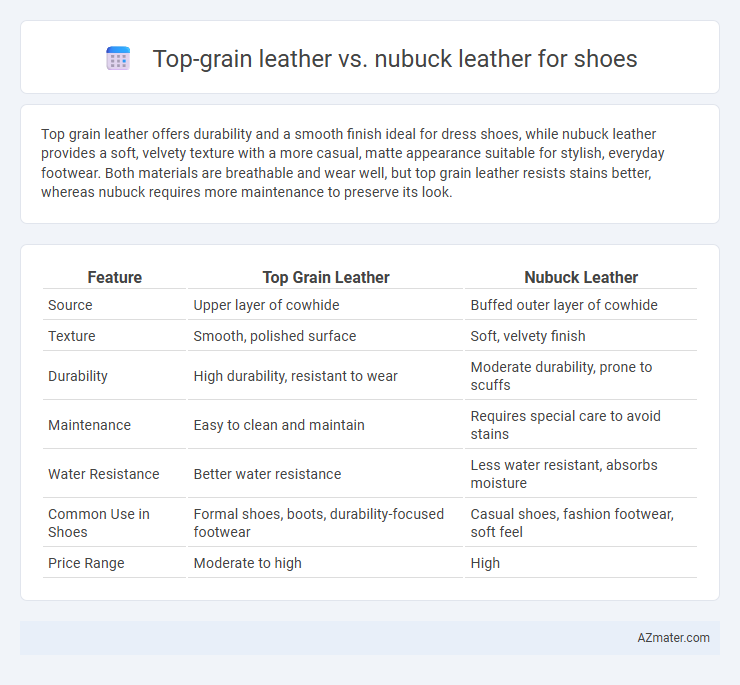Top grain leather offers durability and a smooth finish ideal for dress shoes, while nubuck leather provides a soft, velvety texture with a more casual, matte appearance suitable for stylish, everyday footwear. Both materials are breathable and wear well, but top grain leather resists stains better, whereas nubuck requires more maintenance to preserve its look.
Table of Comparison
| Feature | Top Grain Leather | Nubuck Leather |
|---|---|---|
| Source | Upper layer of cowhide | Buffed outer layer of cowhide |
| Texture | Smooth, polished surface | Soft, velvety finish |
| Durability | High durability, resistant to wear | Moderate durability, prone to scuffs |
| Maintenance | Easy to clean and maintain | Requires special care to avoid stains |
| Water Resistance | Better water resistance | Less water resistant, absorbs moisture |
| Common Use in Shoes | Formal shoes, boots, durability-focused footwear | Casual shoes, fashion footwear, soft feel |
| Price Range | Moderate to high | High |
Introduction to Top Grain Leather and Nubuck Leather
Top grain leather is the second-highest grade of leather, created by sanding and buffing the surface to remove imperfections, resulting in a smooth and durable material ideal for shoes. Nubuck leather is made from the outer side of the hide, sanded to create a soft, velvety texture with a distinctive matte finish, offering a stylish yet delicate option for footwear. Both materials balance durability and aesthetic appeal, making them popular choices in premium shoe manufacturing.
What is Top Grain Leather?
Top grain leather is the second-highest quality leather, created by sanding and buffing the outer layer of the hide to remove imperfections while retaining its natural grain. This type of leather offers durability, resistance to stains, and a smooth, consistent surface ideal for shoe manufacturing. Compared to nubuck, top grain leather provides a polished appearance and greater strength, making it a popular choice for high-quality, long-lasting footwear.
What is Nubuck Leather?
Nubuck leather is a type of top grain leather that has been sanded or buffed on the grain side to create a soft, velvety texture, enhancing its aesthetic appeal and comfort in shoes. Unlike traditional top grain leather, which retains a smooth surface, nubuck offers a matte finish and subtle nap, making it more susceptible to stains but highly breathable. Its unique texture requires careful maintenance to preserve durability and appearance, making it a popular choice for stylish, high-end footwear.
Key Differences Between Top Grain and Nubuck Leather
Top grain leather is created by sanding and refining the outer layer of the hide, producing a smooth, durable surface ideal for polished shoes, while nubuck leather is made by sanding the outer grain to create a soft, velvet-like texture with a matte finish. Top grain leather offers greater resistance to wear, scratches, and stains due to its treated surface, whereas nubuck leather requires more maintenance and waterproofing because of its porous nature. The choice between top grain and nubuck leather hinges on the desired balance between durability and aesthetic appeal for footwear.
Durability: Top Grain Leather vs Nubuck Leather
Top grain leather offers superior durability for shoes due to its dense, tightly packed fibers and resistance to wear and moisture, making it ideal for long-lasting footwear. Nubuck leather, while also durable, features a buffed surface that is more susceptible to scratches and stains, requiring more maintenance to preserve its appearance. Choosing top grain leather enhances shoe longevity, especially in rugged or high-use conditions.
Comfort and Feel: Nubuck vs Top Grain for Shoes
Nubuck leather offers a softer, velvety texture that enhances comfort by conforming closely to the foot, making it ideal for casual and flexible shoe designs. Top grain leather provides a smoother, more polished surface with greater durability but feels stiffer initially, requiring a break-in period to achieve optimal comfort. For shoes prioritizing immediate softness and breathability, nubuck is preferable, while top grain excels in structured support and long-term resilience.
Style and Appearance Comparison
Top grain leather offers a sleek, polished appearance with a smooth surface that enhances classic, formal shoe styles, while nubuck leather provides a soft, velvety texture resulting from sanding the outer layer, lending a more casual and rugged look. The subtle matte finish of nubuck develops a unique patina over time, adding character and depth to the shoe's appearance, unlike the more uniform sheen of top grain leather. Both materials excel in durability; however, nubuck requires more maintenance to preserve its aesthetic, making style choice dependent on desired look and upkeep commitment.
Maintenance and Care Requirements
Top grain leather shoes require regular cleaning with a damp cloth and conditioning every few months to prevent drying and cracking, offering durability with moderate maintenance. Nubuck leather shoes need more frequent brushing with a suede brush to maintain their soft, velvety texture and require waterproofing sprays to protect against stains and moisture. Both types benefit from proper storage away from direct sunlight and excessive humidity to extend their lifespan.
Price and Value Considerations
Top grain leather shoes generally offer a higher price point due to their durability, smooth finish, and resistance to stains, making them a cost-effective choice for long-term use. Nubuck leather shoes, with their soft, velvety texture and premium appearance, tend to be more expensive and require more maintenance, impacting overall value. Consumers seeking a balance between luxury aesthetics and investment durability often weigh the higher upkeep costs of nubuck against the robust, practical nature of top grain leather.
Which Leather is Best for Shoes?
Top grain leather offers durability and water resistance, making it ideal for everyday shoe wear with its smooth texture and ease of maintenance. Nubuck leather, while softer and providing a luxurious, velvety finish, requires more care and is prone to staining, hence better suited for dress shoes or less frequently worn footwear. For robust, long-lasting shoes, top grain leather generally outperforms nubuck in terms of wear resistance and practicality.

Infographic: Top grain leather vs Nubuck leather for Shoe
 azmater.com
azmater.com